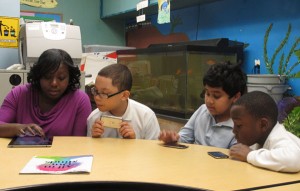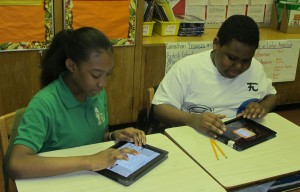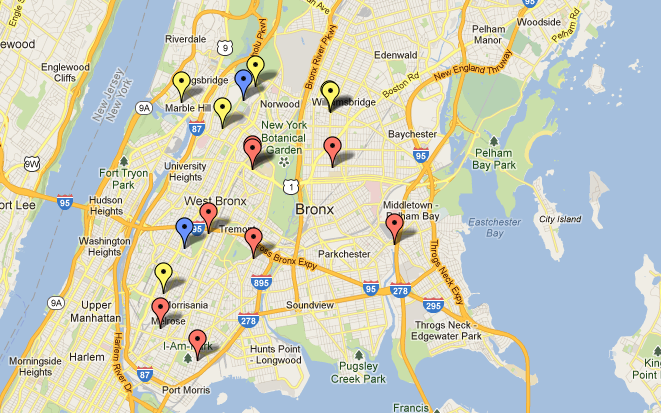
Myrlene Michel, a technology specialist and teacher at the La Guardia Academy of Arts and Technology in the Bronx, brought her own iPad to school to personalize lessons and annotate test prep materials for her students. Her school also spent part of its hardware budget to purchase eight iPads.
Michel wants to buy more iPads for next year, but she says the tablets—whose price for schools runs from $399 to $796 for the most equipped model—aren’t in her school’s budget, so she’s looking into a state learning technology grant and the non-profit donor Web site, DonorsChoose.org.
More and more New York City educators like Michel are looking for ways to bring iPads to their classrooms. While there is little research that the iPad improves learning, some teachers are already using the device because they say it helps them engage students. A few teachers simply bring in their own tablets. Some educators look to grants from non-profit organizations. Others receive federal and state government funds targeted at educational technology. Many others use money already in their budgets that is set aside for software or other technology. To encourage all of them, Apple is publishing guidelines on how to fund its products in the classroom.
The iPad is the latest in a long series of devices that educators have hoped would spark innovation. Many of these have come from Apple, which states in a press release that there are 1.5 million iPads in education. The New York City Department of Education currently has several multi-million dollar contracts with Apple. One contract with Apple is an estimated $83,656,098 for October 2011 through August 2014, according to the New York City comptroller’s site. The department also has a contract for $4.6 million from May 2011 through November 2011, and another contract for $4.6 million from September 2011 through November 2011.
The New York City Department of Education said information about the number of iPads it purchased could only be provided through a Freedom of Information Law request. “Principals decide whether to purchase iPads for instructional purposes,” said Marge Feinberg, a Department of Education spokesperson, explaining the use of technology in schools, such as the iZone, a network of technology-centric schools.
Non-Profit Grants
When Jennifer Konarski, a special education teacher at Public School 181 in Flatbush, Brooklyn, decided an iPad would be a useful resource for her classroom, she logged onto the DonorsChoose Web site, an organization she previously used to ask donors for classroom supplies, from markers to iPods. She wanted an iPad to play educational videos, provide math-building apps, and upload audio books so students could build reading fluency while following along with books.
Now, one month after submitting her application, she has already received about half of the money needed for an iPad3. Konarski said she feels excited when she receives an email notifying her that someone has donated. She likes the fact that anonymous donors care about her classroom.
Konarski said she encourages her students to be comfortable with new devices because they are growing up in a world where navigating technology is crucial. “They definitely have a desire, a thirst, an envy for it,” she said, “and they’re going to need it when they’re adults.”
Federal Funds

The Alain L. Locke Magnet School for Environmental Stewardship in Harlem, an iZone school, recently bought 75 iPads for the fifth grade. The District 3 magnet school got the approximate $30,000 for the iPads through federal magnet school funding for technology. The school chose the iPad2 Wi-Fi only model. Fifth-grade teacher Monica Burns then downloaded free apps for note-taking and math facts and created an interactive social studies textbook using a free app, iBooks Author, on her personal MacBook.
Although the third and fourth-graders at her school use laptops, Burns thinks iPads have advantages: avoiding viruses and quick start-up times. The interactivity of iPads is also a plus. “Just because the Apple design is so intuitive by design, it’s perfect for the children,” she said. “And the touch screen makes it even more child-friendly.”
State Technology Budgets
But while many grants and funds can be used for iPads, teachers say that certain grants, such as the citywide Resolution “A” grants, have rigid guidelines that don’t allow for the purchase of technology, such as iPads.
Some schools implementing technology in their curriculum use the larger Resolution “A” funds for smartboards or laptops, and the smaller, state budgeted funds for iPads. Technology teacher Chris Casal said the Magnet School for Math, Science, and Technology in Park Slope, Brooklyn, used its budgeted state funds to purchase iPads, which teachers use to organize assignments and paperwork. Sometimes a grant will come through two years after the school applied, which will allow more technology to be purchased. “It’s been very much an ongoing process,” he said.
Apple’s Education Initiatives
In addition to school-driven initiatives, iPads also reach classrooms through Apple’s partnerships. Apple’s program with Teach for America last year gave all first and second-year teachers — a total of approximately 8,000 teachers and roughly 500 in New York City — a donated iPad for their classroom, said Kaitlin Gastrock, a Teach for America regional communications director.
Apple has introduced education initiatives, such as iBooks and the iTunesU app. The company provides education-discounted prices on some products, as well as account executives for specific education regions, such as the New York City Department of Education.
Apple also advises educators on how to use federal funds for its products with a series of technical brochures.
Clearly, education is a big market for the iPad, and Apple executives know it. “The iPad has taken off not only in consumer in a meaningful way, but in education and in enterprise, and it’s sort of everywhere you look now,” Apple CEO Tim Cook said in Apple’s second-quarter financial results conference call on April 24. An Apple representative declined to comment for this story.


